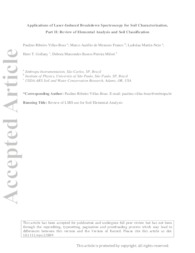Applications of laser-induced breakdown spectroscopy for soil characterization, part II: Review of elemental analysis and soil classification.
Applications of laser-induced breakdown spectroscopy for soil characterization, part II: Review of elemental analysis and soil classification.
Author(s): VILLAS BOAS, P. R.; FRANCO, M. A. M.; MARTIN NETO, L.; GOLLANY, H. T.; MILORI, D. M. B. P.
Summary: In-field soil health assessments, including plant nutrients and toxic elements, are needed and could improve the sustainability of agriculture production. Among the available analytical techniques for these analyses, laser-induced breakdown spectroscopy (LIBS) has become one of the most promising techniques for real-time soil analysis at low cost and without the need of reagents. The first part of this two-part review (Part I, Villas-Boas et al., 2019) in this issue focused on the fundamentals of LIBS for soil analysis and its use for soil chemical and physical characterization. Our objectives in this review article (Part II) are to review (i) the main applications of LIBS in the determination of soil carbon (C), nutrients and toxic elements, spatial elemental mapping, and (ii) its use in soil classification. Traditional and more recent techniques will be compared to LIBS, considering their advantages and disadvantages. LIBS is a promising, versatile technique for detecting many elements in soil samples, requires little or no sample preparation, takes only a few seconds per sample, and has a low cost per sample compared to other techniques. However, overcoming matrix effects is a challenge for LIBS applications in soil analysis, since most studies are conducted with limited changes in the matrix. In spite of the limitation of matrix effects, a typical LIBS system has a limit of detection of 0.3, 0.6, 4, 7, 10, 18, 46, and 89 mg kg -1 for Mo, Cu, Mg, Mn, Fe, Zn, K, and Ca, respectively. LIBS holds potential for real-time in-field spatial elemental analysis of soils and practical applications in precision farming with proper calibration. This could lead to immediate diagnoses of This article is protected by copyright. All rights reserved.contaminated soil and inefficient nutrient supplies and facilitate well-informed soil management, increasing agricultural production while minimizing environmental impacts.
Publication year: 2019
Types of publication: Journal article
Unit: Embrapa Instrumentation
Observation
Some of Embrapa's publications are published as ePub files. To read them, use or download one of the following free software options to your computer or mobile device. Android: Google Play Books; IOS: iBooks; Windows and Linux: Calibre.
Access other publications
Access the Agricultural Research Database (BDPA) to consult Embrapa's full library collection and records.
Visit Embrapa Bookstore to purchase books and other publications sold by Embrapa.

